Wind Hazard Risk Assessment and Management for Structures
Wind Hazard Risk Assessment and Management for Structures
Wind Hazard Risk Assessment and Management for Structures
Create successful ePaper yourself
Turn your PDF publications into a flip-book with our unique Google optimized e-Paper software.
Chapter 1. Introduction 2<br />
Table 1.1: The five costliest U.S. hurricanes, 1900-2006 (Blake et al., 2007).<br />
Hurricane Date Cost of Damage (2006 dollar value)<br />
Katrina August 2005 $84.6 billion<br />
Andrew August 1992 $48.1 billion<br />
Wilma October 2005 $21.5 billion<br />
Charley August 2005 $16.3 billion<br />
Ivan September 2004 $15.5 billion<br />
pirical relationships between wind speed <strong>and</strong> insurance-claim amounts determined from<br />
historical data (e.g. Ch<strong>and</strong>ler et al., 2001; Huang et al., 2001; Sparks, 2003). However,<br />
such relationships may be inaccurate because insurance records are strongly influenced by<br />
human factors (Watson <strong>and</strong> Johnson, 2004). They also do not predict damage to build-<br />
ings that have not been subjected to major wind hazards (Watson <strong>and</strong> Johnson, 2004).<br />
There<strong>for</strong>e, some recent studies have employed structural engineering analysis to simulate<br />
the actual physical damage processes <strong>and</strong> hence the economic loss due to structural dam-<br />
age (e.g. Stubbs <strong>and</strong> Perry, 1996; Pinelli et al., 2004; Unanwa et al., 2000; Vickery et al.,<br />
2006b). Per<strong>for</strong>mance-based design, which is based on the structural damage simulation, was<br />
proposed to strengthen future residences’ resistance against high winds (e.g. van de Lindt<br />
<strong>and</strong> Dao, 2009). By developing a more accurate <strong>and</strong> in-depth structural risk assessment<br />
in tropical cyclone-prone areas, engineers can help the actuaries <strong>and</strong> policymakers better<br />
prepare <strong>for</strong> <strong>and</strong> mitigate the future risk of extreme wind posed to our communities.<br />
1.2 Review on <strong>Wind</strong>-Related Vulnerability Models<br />
1.2.1 Full-Scale Extreme-<strong>Wind</strong> Loss Model<br />
A full-scale extreme-wind loss estimation model includes, but not limited to, calculation of<br />
genesis of extreme winds, evaluation of wind effects on buildings, estimation of insurance<br />
claim amounts based on building damage, etc ˙ , which require knowledge in a range of pro-
















